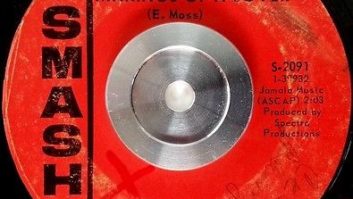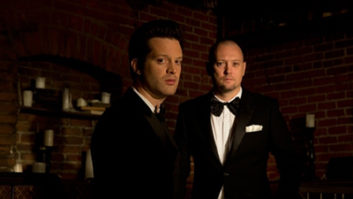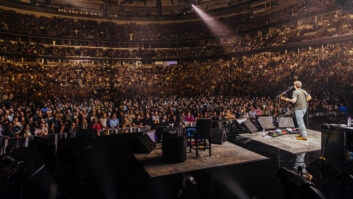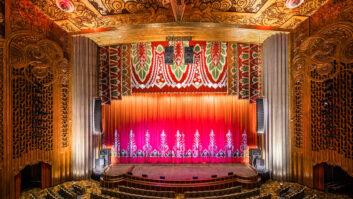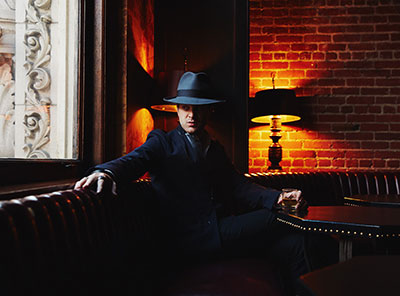
A quiet cul-de-sac in Culver City is the last place you’d expect to find Mayer Hawthorne. But he’s hidden away in the back unit of a modern apartment building, in a narrow L-shaped room on the ground floor with blackout shades hiding sound-deadening panels. This room serves as his studio and his man cave, where vinyl fills the shelves and cassette tapes line the tops, their covers on display. Backlit by his computer monitor, wearing a sweater with a giant stylishly frayed-edged monochrome “M” stitched on it, Hawthorne is wedged in a corner, as much a part of the space as his many synthesizers and guitars.
In this studio, on his own, is where Hawthorne recorded the majority of his fourth album, Man About Town. No stranger to being in the driver’s seat, Hawthorne wrote, produced and mixed his first two albums, A Strange Arrangement (2009) and How Do You Do (2011), and co-produced his last album, Where Does This Door Go (2013). He takes the reins again on Man About Town, realizing his vision all the better after working with Pharrell, Jack Splash, Warren “Oak” Felder, and Greg Wells as co-producers and Manny Marroquin and Michael Brauer as mixers on Where Does This Door Go.
Hawthorne’s referential style to classic musical eras is his signature. For Man About Town, he returns to the ’70s. One of the main components to capture this time is the Yamaha CP70 electric piano at Los Angeles’ The Village with a Boss CE-1 Chorus Ensemble plug-in. But more importantly, he uses the vintage drum machines Maestro Rhythm King MRK-2 and Acetone Rhythm Ace FR-6—one or the other of which features on every song and has shaped the sound of the album—as his vehicles.
“The older and shittier the drum machine sounds, the better,” says Hawthorne, as he lovingly fondles the Rhythm King. “It doesn’t sound like real drums. Once it starts sounding like real drums, then I don’t like it anymore.”
Sly and the Family Stone’s Fresh and There’s A Riot Going On are the reference points for much of Man About Town. The Rhythm King, used on “If You Want Me To Stay” and “It’s A Family Affair,” is what Sly called “the funk box.” It was during the recording of the album The Big Knock, for one of Hawthorne’s other projects, Jaded Incorporated, that vintage drum machines were introduced to his repertoire.
“You can do all the EQ’ing and compressing in the world, but these drum machines are never going to bang like real drums,” says Hawthorne, who also sampled a physical Roland TR-808 through a Fairchild 670 for additional drum sounds. “I use them as character. If the built-in pattern isn’t exactly how I want it, then I go into Pro Tools and chop it up, digitally manipulating and EQ’ing to make it sound new. I play real drums, individually. I play a loop, then loop that or do the hi-hat by itself, all the way through. It gives me more options when I mix. I don’t like any music that has wimpy drums. That comes from growing up in hip-hop, in Detroit, in the ’90s, playing J Dilla, DJ Premier, Pete Rock, Diamond D, D.I.T.C., and Barry White smashing it on the drums.”

Hawthorne records the drums in his small studio with carpet on the floor and panels on every window, to cut down on any room reverb. The sound he’s going for is dead and ring-free but with clarity. He captures this with a beyerdynamic M88 directional microphone, tight and close, something he’s drawn to from vintage soul records like those of the Delfonics. If he has to, he will go even drier by taking the bottom skin off the toms and draping a T-shirt on the snare, tricks he learned from watching clips from the ’70s.
The other microphone that makes an appearance is Groove Tube, which in his early broke days Hawthorne used as a vocal microphone, and still uses for its crisp character and frequency response. Nowadays, he uses a Sony C800G for vocals—he bought Dr. Dre’s microphone from his NWA time without realizing it.
“It’s a newer, crispier-sounding microphone,” says Hawthorne. “But, I don’t want it too pop-y, too modern, and too crispy so I run it through a Heritage Audio DMA73, which is my favorite Neve 1073 clone, and it’s dual so I get two channels out of it. If you go into any major recording studio today, a lot of them are using this microphone, but running it through an Avalon Vt-737 and it will be even brighter. It’s a combination of old and new techniques that moves it forward for me.
“I use the same simple signal chain for everything,” he continues. “I have an HDX card in my Pro Tools rig. And I use the UAD plug-ins a lot on Man About Town. I love the EMT 140 reverb on the vocal, and toward the end I started messing around with the EMT 250.”
Hawthorne keeps things as analog as possible until it becomes inconvenient. It’s in the mixing stage that he makes the necessary adjustments so his music sonically competes with contemporary sounds. Hawthorne mixes as he tracks so he can listen back to the songs during a certain stage of completion to know if they’re right.
“Vintage albums are mostly a bell in the middle,” he says. “There is a lot more width in modern music. The high end, the very top of the frequencies you can hear—the 5k and above and the low end, the 100 Hz and below, are real important. Modern records have a lot more of both of those. The struggle with me is always, ‘How do I make this new?’ I don’t ever just want to make a retro album. I don’t ever just want to redo something that was already done. Somebody already did it and they probably did it better than I can. The goal is always to make something that sounds new, but that uses all the best of the old.”

